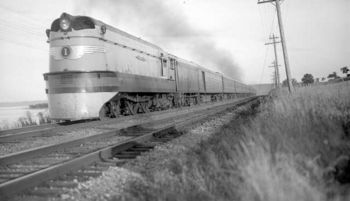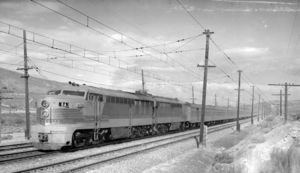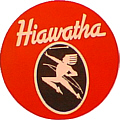Hiawatha (passenger train)

The Hiawathas were named passenger trains operated by the Chicago, Milwaukee, St. Paul and Pacific Railroad (also known as the Milwaukee Road), and traveled from Chicago to the Twin Cities in Minnesota. The first Hiawatha trains ran in 1935. By 1945, there were actually three routes carrying the Hiawatha name:
- the Twin Cities Hiawatha — the main route to Minnesota;
- the North Woods Hiawatha — a spur route off the main line leading from New Lisbon, Wisconsin to Minocqua, Wisconsin; and
- the Midwest Hiawatha — a separate line westward across Illinois and Iowa to Sioux Falls, South Dakota and Omaha, Nebraska (the line split into two parts in Manilla, Iowa).
Early on, the Hiawatha trains were pulled by steam locomotives, though the trains were by no means slow. In fact, these locomotives (Milwaukee classes A and F7) were some of the fastest steam engines ever built, with schedule times on some routes requiring speeds of well over 100 miles per hour (160 km/h). Some believe that these trains styled by Otto Kuhler may have broken the official steam locomotive speed record set by the Mallard, as the trains were said to exceed 120 miles per hour (193 km/h) on a regular basis. Famous was their finned beaver-tail observation car also due to noted industrial designer Otto Kuhler.
The Twin Cities Hiawatha ran twice daily in each direction, with morning and afternoon trains. In 1947, the Olympian train from Chicago to the Pacific Northwest was renamed the Olympian Hiawatha. This train ceased operations on May 22, 1961. The Morning Hiawatha (trains 5 and 6) and Afternoon Hiawatha (trains 3 and 2) continued to operate between Chicago and Minneapolis until the latter train was discontinued on January 23, 1970. During this period both trains operated with a consist including coaches, a Super Dome lounge car, dining car, and a distinctive observation car known as the Skytop Lounge. Designed by Brooks Stevens, this beautiful car contained a drawing room, swiveling parlor seats, and at the rear there was a lounge area with a large expanse of glass windows. Skytop Cedar Rapids has been beautifully restored and it is owned by a Minneapolis-based organization that operates Milwaukee Road 261, a large steam locomotive. The last runs of the Morning Hiawatha were on April 30, 1971 immediately prior to Amtrak.

From June 5, 1971 until October 1, 1979 there was a service known as North Coast Hiawatha that ran from Chicago, Illinois, to Seattle, Washington. At present, the Hiawatha is the name of an 85-mile (137 km) train route operated by Amtrak on the western shore of Lake Michigan.
See Also
The Route of The Hiawatha mountain bike trail.

